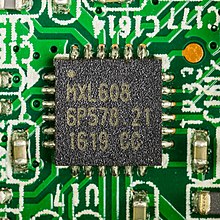Renesas Electronics Corporation is a Japanese semiconductor manufacturer headquartered in Tokyo, Japan, initially incorporated in 2002 as Renesas Technology, the consolidated entity of the semiconductor units of Hitachi and Mitsubishi excluding their dynamic random-access memory (DRAM) businesses, to which NEC Electronics merged in 2010, resulting in a minor change in the corporate name and logo to as it is now.

Cypress Semiconductor Corporation was an American semiconductor design and manufacturing company. It offered NOR flash memories, F-RAM and SRAM Traveo microcontrollers, PSoCs, PMICs, capacitive touch-sensing controllers, Wireless BLE Bluetooth Low-Energy and USB connectivity solutions.

Broadcom Corporation was an American fabless semiconductor company that made products for the wireless and broadband communication industry. It was acquired by Avago Technologies for $37 billion in 2016 and currently operates as a wholly owned subsidiary of the merged entity Broadcom Inc.

CSR plc was a multinational fabless semiconductor company headquartered in Cambridge, United Kingdom. Its main products were connectivity, audio, imaging and location chips. CSR was listed on the London Stock Exchange and was a constituent of the FTSE 250 Index until it was acquired by Qualcomm in August 2015. Under Qualcomm's ownership, the company was renamed Qualcomm Technologies International, Ltd.

Silicon Image Inc. was an American fabless semiconductor company based in Hillsboro, Oregon, and active from 1995 to 2015. The company designed circuits for mobile phones, consumer electronics and personal computers (PCs). It also manufactured wireless and wired connectivity products used for high-definition content. The company's semiconductor and IP products were deployed by manufacturers in devices such as smartphones, tablets, digital televisions (DTVs), and other consumer electronics, as well as desktop and notebook PCs. Silicon Image, in cooperation with other companies, was influential in the creation of some global industry standards such as DVI, HDMI, MHL, and WirelessHD.
Maxim Integrated, a subsidiary of Analog Devices, designs, manufactures, and sells analog and mixed-signal integrated circuits for the automotive, industrial, communications, consumer, and computing markets. Maxim's product portfolio includes power and battery management ICs, sensors, analog ICs, interface ICs, communications solutions, digital ICs, embedded security, and microcontrollers. The company is headquartered in San Jose, California, and has design centers, manufacturing facilities, and sales offices worldwide.
Microchip Technology Incorporated is a publicly listed American corporation that manufactures microcontroller, mixed-signal, analog, and Flash-IP integrated circuits. Its products include microcontrollers, Serial EEPROM devices, Serial SRAM devices, embedded security devices, radio frequency (RF) devices, thermal, power, and battery management analog devices, as well as linear, interface and wireless products.

Broadcom Inc. is an American multinational designer, developer, manufacturer, and global supplier of a wide range of semiconductor and infrastructure software products. Broadcom's product offerings serve the data center, networking, software, broadband, wireless, storage, and industrial markets. As of 2023, some 79 percent of Broadcom's revenue came from its semiconductor-based products and 21 percent from its infrastructure software products and services.

PLX Technology was a manufacturer of integrated circuits focused on PCI Express and Ethernet technologies. On August 12, 2014, Broadcom Inc., acquired the company.
eSilicon is a company engaged in semiconductor design and manufacturing services, that delivers custom ICs and IPs to OEMs.
SiBEAM Inc., a wholly owned subsidiary of Lattice Semiconductor, is a fabless semiconductor company that provides integrated circuits and system solutions for millimeter-wave (mmWave) wireless communications and sensing.

pSemi, is a San Diego–based manufacturer of high-performance RF CMOS integrated circuits. A Murata Manufacturing company since December 2014, the company's products are used in aerospace and defense, broadband, industrial, mobile wireless device, test and measurement equipment and wireless infrastructure markets. Their UltraCMOS technology is a proprietary implementation of silicon on sapphire (SOS) and silicon on insulator (SOI) substrates that enables high levels of monolithic integration.
Lantiq was a Germany-based fabless semiconductor company of approximately 1,000 people formed via a spin-out from Infineon Technologies. The company was purchased in 2015 by Intel for $345M.

Dialog Semiconductor Plc is an Anglo-German semiconductor-based system designer and manufacturer. The company is headquartered in the United Kingdom in Reading, with a global sales, R&D and marketing organization. Dialog creates highly integrated application-specific standard product (ASSP) and application-specific integrated circuit (ASIC) mixed-signal integrated circuits (ICs), optimised for smartphones, computing, Internet of Things devices, LED solid-state lighting (SSL), and smart home applications.

NetLogic Microsystems, Inc. was a fabless semiconductor company that developed high performance products for data center, enterprise, wireless and wireline infrastructure networks. The company was founded in 1995 by Norman Godinho and Varad Srinivasan, became a public company on the NASDAQ exchange under the leadership of CEO Ronald Jankov in July 2004 and was acquired by Broadcom Corporation for $3.7 billion in February 2012.
Ronald Reedy is an American businessman, scientist and researcher. In the semiconductor industry, he advanced silicon on sapphire (SOS) and CMOS technology.
Entropic Communications is a provider of semiconductor products for the connected home. Founded in 2001, the company is headquartered in San Diego, California, US, and maintains offices worldwide. The fabless semiconductor company invented the MoCA® home networking technology, creating Direct Broadcast Satellite (DBS) Outdoor Unit (ODU) single-wire technology, and developing the industry's first ARM® processor and OpenGL graphics Set-top box (STB), System-on-a-Chip (SoC). Entropic completed its initial public offering on December 7, 2007, listing on the NASDAQ exchange under the ticker symbol ENTR.

Qorvo, Inc. is an American multinational company specializing in products for wireless, wired, and power markets. The company was created by the merger of TriQuint Semiconductor and RF Micro Devices, which was announced in 2014 and completed on January 1, 2015. It trades on Nasdaq under the ticker symbol QRVO. The headquarters for the company originally were in both Hillsboro, Oregon, and Greensboro, North Carolina, but in mid-2016 the company began referring to its North Carolina site as its exclusive headquarters.

Exar Corporation was an American semiconductor manufacturer active from 1971 to 2017 as a subsidiary of the Japanese firm Rohm. It was acquired by MaxLinear in May 2017 and maintained as a wholly owned subsidiary for a short while.









